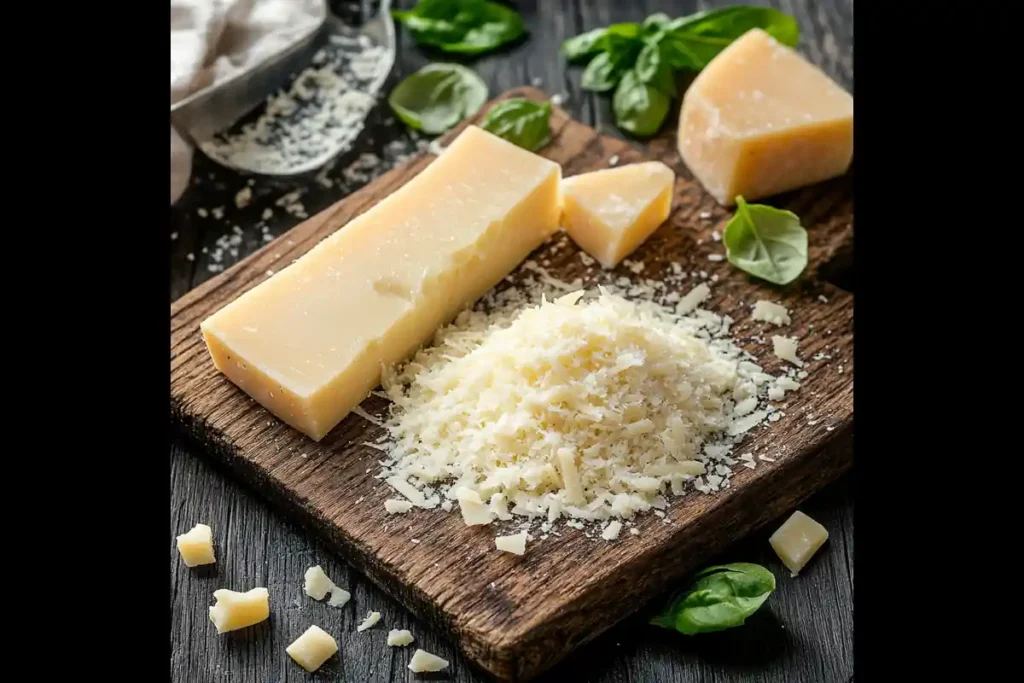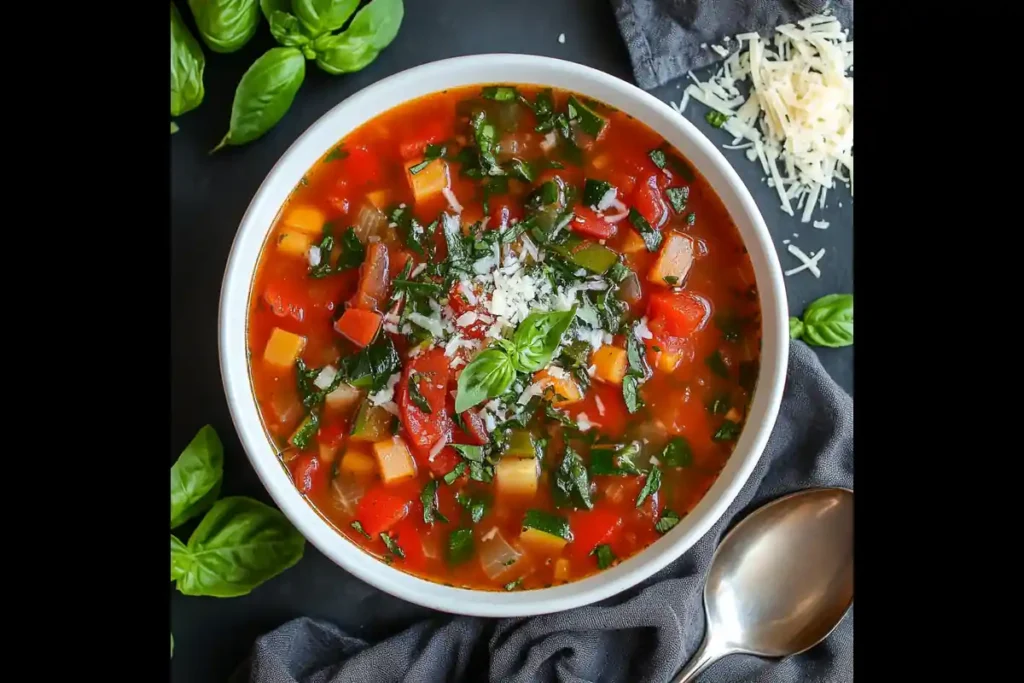Does Parmesan cheese thicken soup? In this article, we’ll explore how it affects texture, when to use it, and the best ways to incorporate it for a rich, flavorful consistency.
Understanding the Role of Parmesan in Soup
Parmesan cheese is not typically used as a primary thickening agent. However, its properties can affect the texture of soup. Consequently, it’s important to understand how it works. Parmesan adds flavor, but its impact on thickness is more subtle. This section explores the specific ways Parmesan alters a soup’s consistency. Therefore, we’ll analyze its components and behavior in hot liquid.
How Parmesan Reacts in Hot Liquid

Parmesan is a hard, dry cheese. Therefore, when added to hot soup, it melts. The melting process releases fats and proteins into the liquid. This alters the soup’s overall texture. However, it is not as effective as other traditional thickeners like flour or cornstarch. Moreover, the grated texture of the cheese matters. Therefore, it dissolves in the soup and may add body. In addition, the degree of melting will also depend on the temperature of the soup and the amount of cheese added.
The Difference Between Parmesan and Other Thickeners
Thickeners such as flour or cornstarch contain starches. Consequently, these starches absorb water and swell, increasing the viscosity. Parmesan, on the other hand, is primarily fat and protein. Because of this, it contributes richness. Parmesan cheese does contribute some thickening, but it is not the same as those starch-based agents. Therefore, consider this before relying solely on it. For instance, starch will alter the entire liquid’s consistency, while Parmesan creates a more velvety texture due to its fat content.
Does Parmesan Cheese Thicken Soup: A Closer Look
While Parmesan does add body, it’s important to manage expectations. It will not drastically thicken a thin soup. Therefore, understand its specific effects. So, does Parmesan cheese thicken soup? The answer is yes, but only slightly. Moreover, the extent of the change depends on how much cheese is added. Furthermore, the type of soup plays a role in how well the cheese can alter the texture.
When to Add Parmesan for Texture

Parmesan is best added toward the end of the cooking process. Accordingly, adding it too early might make it grainy. Furthermore, when the soup is nearly finished, stir in the Parmesan. This will ensure a smooth texture. As a result, the cheese melts evenly. Consequently, the heat should be low to prevent clumping. The texture will be creamy and lightly thicker. Specifically, gentle stirring ensures that the cheese is properly distributed and incorporated into the soup.
How Much Parmesan Is Enough?
Adding too much Parmesan can overwhelm the soup’s flavor. Furthermore, it can make it overly salty. Therefore, use Parmesan sparingly. A few tablespoons for a large pot is often sufficient. Moreover, it’s good practice to taste as you go. As a result, you can adjust the amount. Typically, using a moderate amount will enhance the existing consistency. Therefore, adding it in small increments allows for better control.
The Flavor Impact of Parmesan in Soup
Aside from texture, Parmesan greatly improves the flavor of soup. It offers a rich, savory, and salty note. This depth complements many different kinds of soups. Moreover, the cheese’s nutty undertones are often desirable. So, while considering thickening, do not forget the flavor benefits. This complexity of flavor makes it a very popular choice for finishing soups.
Parmesan as a Flavor Enhancer
Adding Parmesan to soup enriches its overall flavor profile. Therefore, it makes it more complex and satisfying. Accordingly, it’s frequently used in Italian soups, such as minestrone. In addition, it can be used in vegetable-based options. Furthermore, it complements many herbs and spices. Therefore, consider this when enhancing flavor. In particular, its umami quality contributes to the depth of taste.
Combining Parmesan with Other Ingredients
The salty flavor of Parmesan works well with other strong flavors. For instance, herbs like thyme or rosemary. Also, it pairs well with garlic. Moreover, a bit of black pepper enhances its taste. Therefore, when adding Parmesan, consider complementary ingredients. As a result, the soup will be more balanced. In addition to common herbs, consider adding a touch of red pepper flakes for added zest.
Alternative Thickeners When Parmesan Isn’t Enough
Sometimes, Parmesan alone isn’t enough for the desired thickness. So, it’s helpful to know other options. There are several methods for thickening soup. Moreover, these can be used alongside Parmesan. As a result, you can get the perfect consistency. Therefore, a combination of methods often works best.
Starches: Flour and Cornstarch
Flour and cornstarch are common thickening agents. They are easy to use and effective. First, mix a tablespoon of starch with cold water. This is called a slurry. Afterward, whisk this mixture into the hot soup. As a result, the soup thickens as it simmers. Therefore, starches are reliable when a more significant change is needed. Furthermore, using a whisk helps to prevent lumps from forming in the soup.
Cream and Other Dairy
Cream or milk can also thicken soup. However, these add richness and flavor. Therefore, they affect the consistency differently than starches. Additionally, dairy can curdle if heated too much. As a result, you should add dairy toward the end. Furthermore, a smaller amount goes a long way. For instance, using half-and-half instead of full cream can reduce the calorie count without a large sacrifice in texture.
Vegetable Purees
Blending some of the vegetables in the soup is another method. Therefore, you’ll get both flavor and thickness. You can achieve this with an immersion blender. Moreover, this method adds natural body. Therefore, blending is good if you prefer a natural approach. Finally, you can puree vegetables before adding them to the soup. For example, pureed potatoes add both thickness and a subtle earthy flavor.
Parmesan Rind and Soup
The rind of Parmesan is sometimes added to soups for extra flavor. Furthermore, it does add some thickening. However, it does not dissolve like grated cheese. So, it’s important to know how the rind functions in soup. This section will cover its impact on consistency and flavor. Moreover, knowing how to handle it properly is key.
How Parmesan Rind Adds Flavor
The rind of Parmesan has a concentrated flavor. Therefore, adding it to soup imparts a more intense cheesy taste. Additionally, it softens in the liquid. It does not melt like the grated cheese. So, adding the rind allows you to infuse the flavor during simmering. Consequently, it’s removed before serving. Furthermore, using the rind is an efficient method to utilize all parts of the cheese.
Does Parmesan cheese thicken soup using the rind?
While the rind does not melt into the soup, it does release components that contribute a subtle thickening effect. Specifically, collagen and other proteins are released. Additionally, as the rind softens, it can impart a slight increase in viscosity. Therefore, the rind is not the best for thickening alone. However, it adds to both flavor and a bit of texture. In fact, the thickening is due to the breakdown of the proteins.
When to Use Parmesan Rind
Add Parmesan rind at the beginning of the cooking process. Therefore, it will have enough time to flavor the soup. Furthermore, simmer it gently. Remove it before serving. Consequently, you will have the flavor without any unpleasant texture. Remember to strain the soup for a smooth consistency. Specifically, be sure to fish it out before blending with an immersion blender.
Using Parmesan in Various Soup Types
Parmesan is versatile and works well in many soups. Therefore, knowing where it fits best helps. Here, we will explore specific soups that benefit from Parmesan. So, understanding this can enhance your soup recipes. Additionally, understanding why Parmesan works well in specific soups adds depth to culinary skills.
Parmesan with Vegetable-Based Soups
Vegetable soups gain depth from Parmesan. For example, tomato soup or minestrone. Adding Parmesan balances their natural sweetness. Consequently, the cheese brings a salty and savory note. Therefore, it’s a popular addition in many vegetarian dishes. Moreover, it will add a pleasant richness. The umami flavor that Parmesan provides makes these soups more satisfying.
Parmesan in Creamy Soups
Parmesan also works in creamy soups like potato or broccoli. Therefore, it complements the creamy texture. Furthermore, it offers a sharper flavor. It will prevent the soup from being bland. Therefore, consider the cheese’s saltiness when seasoning. As a result, you can adjust the salt. In fact, the sharpness can cut through the richness to create a perfect balance.
Parmesan with Broth-Based Soups
Broth-based soups, such as chicken noodle, can be enhanced with Parmesan. Accordingly, it adds a deeper flavor. Moreover, it will help to create a more substantial body. Additionally, it can make the soup more satisfying. Therefore, Parmesan is a flexible ingredient. This is especially helpful when the broth is light and needs more character.
Exploring the Nutritional Benefits of Parmesan
Beyond flavor and texture, Parmesan offers some nutritional advantages. So, understanding these benefits can make it a more mindful addition. This section will briefly cover what Parmesan brings to the table nutritionally. This way you can feel good about using it in moderation.
Parmesan as a Source of Calcium
Parmesan is rich in calcium. Therefore, this is good for bone health. It provides a dense source of this mineral. As a result, adding it to soups can increase your calcium intake. Furthermore, it’s especially good for people with limited milk intake.
Parmesan and Protein
Parmesan also contains a good amount of protein. This is essential for building and repairing tissues. Therefore, adding it to soups makes them more protein-rich. Accordingly, it helps with overall satiety. It may also aid muscle development and maintenance.
Things to Consider about Parmesan’s Nutritional Profile
While Parmesan has beneficial nutrients, it is also high in sodium. Furthermore, it contains a fair amount of fat. So, it’s good to use Parmesan in moderation. Consequently, people with dietary restrictions should check the levels of sodium. Additionally, keep these points in mind while making mindful additions.
Tips for Using Parmesan in Soup
Using Parmesan correctly is key to achieving the best results. So, here are some tips to improve your technique. As a result, you will have the best soup every time. Consider these points for Parmesan in soups. Furthermore, mastering these methods can dramatically improve your cooking skills.
Grating Parmesan Properly
Freshly grated Parmesan is better than pre-grated. Therefore, it melts smoother into the soup. Moreover, the flavor is fresher. So, using a fine grater will help it dissolve better. Consequently, it will be less grainy. Always grate the cheese just before adding it to the soup. In particular, pre-grated cheese often includes cellulose. Therefore, it doesn’t melt as well.
Controlling Saltiness
Parmesan is naturally salty. Therefore, be careful when adding other salt to the soup. Taste frequently to adjust accordingly. So, it’s best to add salt at the very end of the cooking process. Consequently, this prevents over-seasoning. Specifically, start with a small amount of salt and then add more as needed.
Storage and Shelf Life
Store Parmesan properly to keep its quality. As a result, the flavor and texture will stay at their best. Keep it in an airtight container. Additionally, place it in the refrigerator. Therefore, grated Parmesan should be used within a few days. Keep the rind in the freezer for future soup. Furthermore, a block of Parmesan will last much longer than grated.
Innovative Ways to Use Parmesan in Soup
Beyond just grating, there are some more innovative ways to include Parmesan in soups. These methods can enhance not just the taste and texture, but also the presentation. Consider trying these tips to add an elevated touch.
Parmesan Crisps as a Garnish
Creating small crisps from Parmesan adds a crunchy texture. These are made by melting grated cheese on parchment paper. So, place a small mound of grated Parmesan onto the paper. Then, bake it until crispy. Finally, use these as a garnish. This adds a beautiful textural contrast.
Parmesan Infused Oil
Infusing olive oil with Parmesan rind adds another layer of flavor. So, place the rind in a jar of olive oil. Leave it in the fridge for several days. As a result, the oil will take on the Parmesan flavor. This oil can be drizzled over the soup. Therefore, it will boost the cheesy notes.
Parmesan and Bread Crumb Topping
Combining grated Parmesan with bread crumbs adds texture. Therefore, toast the crumbs with garlic and Parmesan. Then, use this mixture as a crunchy topping. Consequently, this offers an interesting alternative to regular croutons. It adds a savory touch.
Conclusion: Does Parmesan Cheese Thicken Soup?
In conclusion, does Parmesan cheese thicken soup? The answer is that it contributes to the texture. However, it’s not a primary thickener like starches. Therefore, Parmesan should be used for its flavor and subtle thickening. Its main contribution is a rich, salty taste. Accordingly, use it wisely in your recipes. Parmesan makes soups more enjoyable. Furthermore, with these tips, you can fully leverage its potential.

